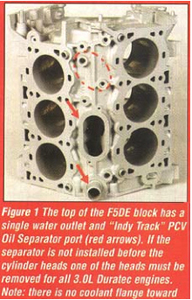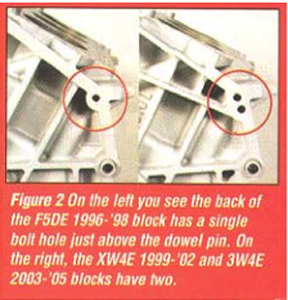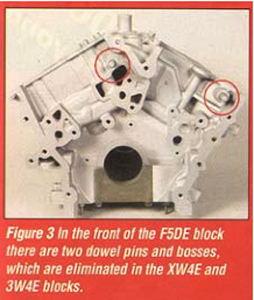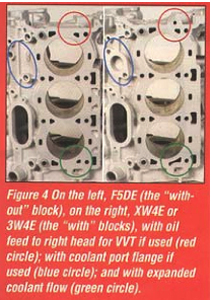By Roy Berndt
 The Duratec 30 is an aluminum block with cast iron liners, aluminum DOHC cylinder head with four valves per cylinder, fracture-split (cracked) forged powder metal connecting rods, and a forged steel crankshaft. There are two versions of the Duratec 30:
The Duratec 30 is an aluminum block with cast iron liners, aluminum DOHC cylinder head with four valves per cylinder, fracture-split (cracked) forged powder metal connecting rods, and a forged steel crankshaft. There are two versions of the Duratec 30:
DAMB – Lincoln LS, Jaguar, Mazda 6 and MPV, which use direct-acting mechanical bucket (DAMB) tappets. Here the camshaft sits directly above the valves with different thickness pucks for adjustment. Output is 232 hp.
RFF-Taurus/Sable/Escape/Tribute use roller finger followers (RFF) with the camshaft offset acting on the roller, which pivot on a hydraulic lash compensator. Output is 208 hp.
Knowing the look of the two different styles of heads helps distinguish between Taurus/Sable – Escape/Tribute or Lincoln LS /Jaguar.
Production numbers of the 3.0L Duratec started out slowly in 1996 through 1999 but increased significantly once it became the Taurus/Sable base engine and then for the Escape and Tribute in 2001. One half a million of these engines have been produced per year, putting total production at about 3.5 million 3.0L Duratec engines manufactured. With that fleet now approaching 14 years old, they will start showing up for reman/build in respectable numbers soon, if not already.

As always, the Ford Broadcast Code sticker is the most valuable tool in determining the exact configuration and application identification. Unfortunately, it is still a paper sticker usually located on the cam/rocker cover and, in some cases, the front cover. These stickers are often damaged, unreadable or gone, which makes it nearly impossible to purchase an engine core when you cannot properly identify that engine. Our intent is for you to be able to avoid that problem with the information provided in this Comprehensive Progression (ComPro) of the 3.0L Duratec engine.
BLOCKS
1996-’98 Taurus/Sable
F5DE is the casting number for the first generation of the 3.0L Duratec, which, in reality, is not much more than an overgrown 2.5L. There have been reports of an F7DE block, however I have never been able to locate one. In any case, it would be identical so we won’t fuss over it.
This is an all aluminum block with cast iron liners. Boring this engine oversize is not a problem, and oversize pistons are readily available.

Let’s start at the top (Figure 1) and work our way around to the front and rear. There is a single water outlet tube at the back with an "Indy Track" shape opening for the early style PCV oil separator about in the center of the block. Note that there is not another coolant flange toward the front.
If the PCV oil separator is not installed on the block prior to the installation of the cylinder heads, it cannot be installed without one head being removed. If you find yourself in this situation the right side head easiest to remove. It can also be installed backwards, so always install with the hose outlet to the rear of the engine. There are also two types with different PCV flow and hose sizes.
In the trans-mount area at the back of the block the F5 block has only one bolthole (Figure 2) just above the dowel on the right side. Moving to the front of the block (Figure 3) the F5DE has two dowel pins mounted in the front, both of which are eliminated in all subsequent blocks. This block has a 12mm thread detonation sensor boss.
1999 Taurus/Sable
XW4E – AE, AG is the casting number for 1999 only because it’s the only XW block with a 12mm det sensor boss. It has a provision for the oil feed to the right side cylinder head (Figure 4) to use with variable valve timing (VVT) although it’s not being used. There are also coolant port changes that occurred on the right side that required a new design head gasket. A coolant port flange with two boltholes can be found on the top of the block used in the Lincoln LS and Mazda MPV. This flange is plugged for all other applications. This block now has two boltholes in the trans mount flange area on the right side above the dowel (Figure 2). Typically you will find the casting number for this block in the lower area just above the bedplate.

2000-’05 Taurus/Sable, Escape/Tribute, Lincoln LS, Jaguar S & X, Mazda MPV and 6
XW4E- BA is the casting number for 2000-’02 and you will find the casting number high on the block just under the cylinder head deck or along the top of the trans mount flange on the right side. In 2003-’05 casting number 3W4E came on the scene. I have seen Broadcast Code engines that were 2003 and 2004 and had XW4E blocks. If you’re a purist I leave it to your own heart; otherwise I consider the blocks to be fully interchangeable.
In fact, the blocks are identical to the 1999 block except the det sensor now has 8mm threads. Since this is nearly identical to the det sensor situation with the 4.6L Ford, I would assume that the same companies that provide those adaptors and tooling should be able to do the same for the 3.0L Duratec.
Article courtesy of ENGINE BUILDER magazine.












